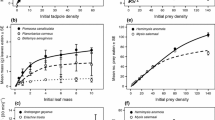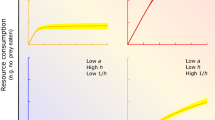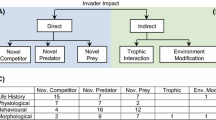Abstract
Dick et al. (Biol Invasions, 2017) propose that the comparative functional response framework provides a unifying approach for the study of invasive species. We agree that functional responses are an important and powerful quantitative description of consumer effects on resources, and co-opting classical ecological theory to better predict invasive species impacts is a laudable move for invasion biology. However, we fear that the early successes of select examples of the comparative functional response (CFR) approach has led Dick et al. to exaggerate the generality of its utility, and about its ability to unify the field. Further, they fail to provide a convincing argument why CFR is better than existing tools such as invasion history or impact indices, even when considering emerging or potential invaders. In this response we provide details of three conceptual issues stemming from classical ecological theoretical frameworks and two practical problems that Dick et al. and other CFR proponents need to address.

Similar content being viewed by others
References
Altwegg R, Eng M, Caspersen S, Anholt BR (2006) Functional response and prey defence level in an experimental predator–prey system. Evol Ecol Res 8:15–128
Blackburn TM, Essl F, Evans T, Hulme PE, Jeschke JM, Kühn I, Kumschick S, Mrugała A, Marková Z, Nentwig W, Pergl J, Pyšek P, Rabitsch W, Ricciardi A, Richardson DM, Sendek A, Vilà M, Wilson JRU, Winter M, Genovesi P, Bacher S (2014) A unified classification of alien species based on the magnitude of their environmental impacts. PLoS Biol 12:e1001850
Dick JTA, Alexander ME, Ricciardi T, Laverty C, Downey PO, Xu M, Jeschke JM, Saul W-C, Hill MP, Wasserman R, Barrios-O’Neill D, Weyl OLF, Shaw RH (2017) Functional responses can unify invasion ecology. Biol Invasions. doi:10.1007/s10530-016-1355-3
Elton CC (1958) The Ecology of Invasions by Animals and Plants. Springer, Netherlands
Fenton A, Spencer M, Montagnes DJS (2010) Parameterising variable assimilation efficiency in predator–prey Oikos 119:1000–1010
Guo Z, Sheath D, Amat Trigo F, Britton JR (2016) Comparative functional responses of native and high-impacting invasive fishes: impact predictions for native prey populations. Ecol Freshw Fish. doi:10.1111/eff.12297
Haddaway NR, Wilcox RH, Heptonstall RE, Griffiths HM, Mortimer RJ, Christmas M, Dunn AM (2012) Predatory functional response and prey choice identify predation differences between native/invasive and parasitised/unparasitised crayfish. PLoS ONE 7:e32229
Hastings A (1998) Population Biology, concepts and models. Springer, New York
Hui C, Richardson DM, Landi P, Minoarivelo HO, Garnas J, Roy HE (2016) Defining invasiveness and invasibility in ecological networks. Biol Invasions 18:971–983
Kratina P, Vos M, Anholt BR (2007) Species diversity modulates predation. Ecology 88:1917–1923
Kulhanek SA, Ricciardi A, Leung B (2011) Is invasion history a useful tool for predicting the impacts of the world’s worst aquatic invasive species? Ecol Appl 21:189–202
Leibold M (1996) A graphical model of keystone predators in food webs: trophic regulation of abundance, incidence, and diversity patterns in communities. American Naturalist 147:784–812
Levine JM, Adler PB, Yelenik SG (2004) A meta-analysis of biotic resistance to exotic plant invasions. Ecol Lett 7:975–989
McCoy MW, Bolker BM (2008) Trait-mediated interactions: influence of prey size, density and experience. J Anim Ecol 77:478–486
McCoy MW, Bolker BM, Warkentin KM, Vonesh JR (2011) Predicting predation through prey ontogeny using size-dependent functional response models. Am Nat 177:752–766
McDonald-Madden E, Sabbadin R, Game ET, Baxter PWJ, Chadès I, Possingham HP (2016) Using food-web theory to conserve ecosystems. Nature communications 7:10245. doi:10.1038/ncomms10245
McKinney ML, Lockwood JL (1999) Biotic homogenization: a few winners replacing many losers in the next mass extinction. Trends Ecol Evol 14:450–453
Okuyama T, Bolker BM (2012) Model-based, response surface approaches to quantifying indirect interactions. In: Ohgushi T, Schmitz O, Holt R (eds) Ecology and evolution of trait-mediated indirect interactions: linking evolution, community, and ecosystem. Cambridge University Press, Cambridge, pp 186–204
Rall CB, Guill C, Brose U (2008) Food-web connectance and predator interference dampen the paradox of enrichment. Oikos 117:202–213
Rosenzweig M, MacArthur R (1963) Graphical representation and stability conditions of predator–prey interaction. American Naturalist 97:209–223
Smith-Ramesh LM, Moore AC, Schmitz OJ (2016) Global synthesis suggests that food web connectance correlates to invasion resistance. Glob Change Biol. doi:10.1111/gcb.13460
van Wilgen NJ, Roura-Pascual N, Richardson DM (2009) A quantitative climate-match score for risk-assessment screening of reptile and amphibian introductions. Environ Manage 44:590–607
Acknowledgements
We gratefully acknowledge the support of the DST-NRF Centre of Excellence for Invasion Biology, for a CIB fellowship to MM, hosting JV, funding JM and for facilitating a workshop on Functional Responses in Invasion Biology at Stellenbosch University, South Africa, in November 2015. In addition, we thank Jaimie Dick and colleagues for their stimulating Flashpoint.
Author information
Authors and Affiliations
Corresponding author
Rights and permissions
About this article
Cite this article
Vonesh, J., McCoy, M., Altwegg, R. et al. Functional responses can’t unify invasion ecology. Biol Invasions 19, 1673–1676 (2017). https://doi.org/10.1007/s10530-016-1356-2
Received:
Accepted:
Published:
Issue Date:
DOI: https://doi.org/10.1007/s10530-016-1356-2




